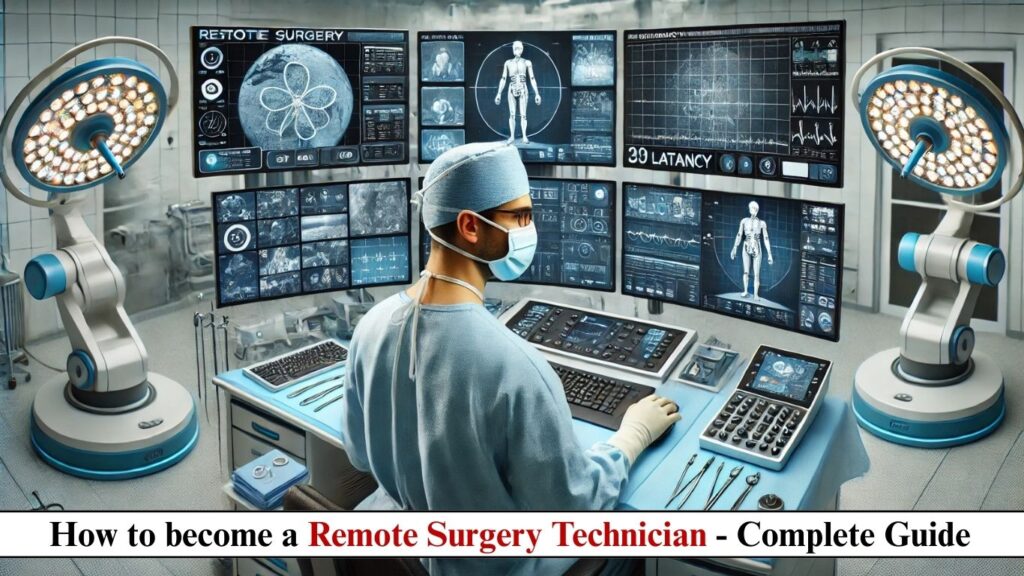
Introduction to Remote Surgery Technology
The global telesurgery market is projected to reach $2.8 billion by 2030, creating unprecedented demand for Remote Surgery Technicians. These highly skilled professionals serve as the critical bridge between surgeons and robotic systems, enabling life-saving procedures across continents.
This comprehensive guide covers:
- Evolution of remote surgery technology
- Global salary benchmarks
- Day-to-day responsibilities
- Required certifications
- Step-by-step career path
- Future industry trends
Whether you’re a surgical tech, robotics engineer, or medical student, this guide reveals how to enter this cutting-edge field at the intersection of medicine and technology.
History of Remote Surgery
Pioneering Era (1980s-2000)
- 1985: First documented robotic surgery (PUMA 560 for neurosurgery)
- 1997: Jacques Marescaux performs transatlantic gallbladder surgery (Lindbergh Operation)
- 2000: FDA approves da Vinci Surgical System
Technological Leap (2001-2015)
- 2003: First remote coronary artery bypass
- 2010: 5G networks enable real-time haptic feedback
- 2014: NASA tests surgical robotics for space medicine
Modern Revolution (2016-Present)
- 2019: First 5G remote brain surgery (China)
- 2022: AI-assisted autonomous suturing achieves FDA breakthrough status
- 2024: Holographic surgical guidance enters clinical trials
Remote Surgery Technician Salary (2024)
| Experience Level | Average Salary (US) | Global Variations |
|---|---|---|
| Entry-Level (0-2 yrs) | $75,000-$95,000 | +25% in Switzerland |
| Mid-Career (3-5 yrs) | $95,000-$135,000 | +30% in UAE |
| Senior (5+ yrs) | $135,000-$190,000 | +40% hazard pay for warzone ops |
Specialty Premiums:
- Neurosurgery support: +$20,000
- Multi-system coordination: +$15,000
- Military/space medicine: +$35,000
Roles & Responsibilities
1. Robotic System Management
- Calibrate force feedback sensors (0.1mm precision)
- Troubleshoot latency issues (<200ms critical threshold)
- Sterilize end-effector tools per Joint Commission standards
2. Surgical Team Coordination
- Maintain triple-redundant communication channels
- Monitor vital sign feeds from remote OR
- Implement fail-safe protocols during network disruptions
3. Pre-Procedure Setup
- Conduct network stress tests (5G/6G/satellite)
- Verify holographic anatomy overlays
- Position robotic arms for optimal ergonomics
4. Real-Time Support
- Adjust tissue resistance algorithms
- Activate AI-assisted bleed detection
- Document procedure metadata for ML training
5. Post-Op Protocols
- Download robotic movement logs
- Recharge haptic feedback gloves
- Sanitize 3D visualization headsets
Required Qualifications
Education Pathways
| Background | Career Entry Point | Recommended Programs |
|---|---|---|
| Surgical Technology | Clinical Specialist | CST + Intuitive Surgical Cert |
| Biomedical Engineering | Systems Engineer | MIT Medical Robotics MSc |
| Computer Science | Network Architect | Stanford Telemedicine Program |
Technical Skills
- Robotic Platforms: da Vinci Xi, Senhance, Versius
- Network Protocols: 5G URLLC, LEO satellite backup
- Surgical Workflows: WHO Safe Surgery Checklist
Certifications
- Certified Robotic Surgery Assistant (CRSA)
- Telemedicine Technical Specialist (ATA)
- Network Reliability Engineer (Google Cloud)
- Advanced Cardiac Life Support (ACLS)
How to Get Started: 5-Step Roadmap
Step 1: Build Foundational Knowledge
- Complete Intuitive Surgical’s da Vinci Training
- Study IEEE 11073 Medical Device Communication
- Shadow hybrid OR procedures
Step 2: Gain Hands-On Experience
- Entry-Level Roles:
- Robotic Surgery Circulator ($65k)
- Biomedical Equipment Technician
- Alternative Paths:
- Military surgical teams
- Virtual OR simulator testing
Step 3: Specialize
- High-Demand Niches:
- Telesurgery network security
- Haptic feedback optimization
- Space medicine protocols
Step 4: Earn Advanced Certs
- FCC Spectrum Management for Medical Devices
- Surgical Robotics Maintenance (Original Equipment Manufacturer)
- Disaster Response Telemedicine (WHO)
Step 5: Secure Target Roles
- Top Employers:
- Mayo Clinic Center for Connected Care
- Medtronic Telestration Services
- SpaceX Medical Operations
Future Scope & Trends
1. Next-Gen Technologies
- 2026: First autonomous trauma surgery drones
- 2028: Quantum-encrypted surgical networks
2. New Applications
- Undersea surgery from surface ships
- Autonomous battlefield medic robots
3. Market Growth
- $4.3B telesurgery market by 2032
- Africa/Asia leading adoption due to specialist shortages
4. Career Innovations
- Surgical Metaverse Architects
- Neural Interface Technicians
Conclusion: Is This Career Right For You?
✅ Ideal Candidate:
- Thrives in high-stakes environments
- Excels at multitasking under pressure
- Passionate about medical technology convergence
🚀 Action Plan:
- Obtain CST certification within 6 months
- Complete da Vinci system training
- Network at AANS/CNS meetings
- Specialize in one robotic platform
With 1.7 billion people lacking access to surgical care, remote surgery technicians will play a pivotal role in global health equity.
Want our free telesurgery equipment checklist? Comment below!
Questions about military vs civilian career paths? Ask here!













Post Comment